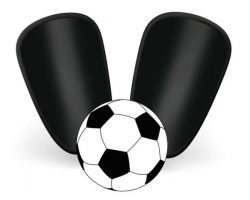- service@personalisedshinpads.com
- Monday - Sunday: 24/7 Order Fulfilment
The History of Shin Pads
The Introduction of Shin Pads into Football.
The Origin Story of Shin Pads.
The origin of shin pads can be traced back to ancient civilizations such as the Greeks, who used greaves made of bronze or other metals to protect their shins in battle. However, the modern-day shin pads used in football and other sports were invented in the early 20th century.
The credit for inventing the modern-day shin pad is often given to a British footballer named Samuel Widdowson. The story goes, Widdowson was playing for Nottingham Forest in a match against Sheffield United in 1874 when he suffered a broken leg after being kicked in the shin. As a result, he decided to create a protective device to prevent such injuries in the future.
Widdowson’s invention was a rudimentary form of shin pad made of leather and wool, which he attached to his legs using straps. Over time, the design of shin pads evolved, with newer materials such as plastics and foams being used to create more lightweight and comfortable versions. Today, shin pads are an essential part of a footballer’s kit and are designed to provide maximum protection while also allowing for freedom of movement.

GET 30% OFF ON PERSONALISED SHIN PADS TODAY
Did Samuel Widdowson Invent Modern Day Shin Pads?
Although it is rumoured that Widdowson was the first person to make shin pads from pieces of cricket pads sewn into his socks and In 1887, and the Nottingham Forest football team became the first team to wear shin guards during a match there are no official records or reports of him suffering a broken leg or inventing shin pads.
In fact, the first known use of shin pads in football was in a match between Newcastle United and Woolwich Arsenal in 1894, which was several years after Widdowson retired from playing.
Therefore, it is unclear how shin pads were invented, but they are believed to have developed over time as a response to the high incidence of leg injuries in football. It is likely that various players and manufacturers experimented with different materials and designs until the shin pad as we know it today was developed.
How Did The Greeks Use Shin Pads?
In ancient Greece, soldiers and athletes wore a type of leg protection called “greaves,” which were made of various materials, including bronze, leather, and linen. Greaves was worn to protect the lower legs from injury during battle or athletic competition, including foot races and various forms of combat.
The origins of greaves in ancient Greece are unclear, but they are believed to have been developed in response to the need for protective legwear in warfare. The earliest recorded use of greaves in Greece dates to the 5th century BC, during the Classical period.
The ancient Greek historian Herodotus wrote about the use of greaves by the Persian army during the Battle of Marathon in 490 BC. According to Herodotus, the Persians wore “trousers of linen,” which covered their legs up to the knee, and “on their feet and legs they had boots of rawhide, and on their heads felt caps.” The use of leg protection in warfare was also common among the Greek city-states, including Athens and Sparta.
The use of greaves in ancient Greece eventually spread to other cultures, including the Romans and the Celts, who developed their own variations of leg protection for use in battle and sport. While the ancient Greek greaves were not the same as the modern-day shin pads used in football and other sports, they are one of the earliest forms of leg protection in human history.
Have Shin Pads Always Been Mandatory?
Shin pads have been mandatory in professional football for several decades, and it is now a requirement for all players to wear them during matches. However, there was a time in the early history of football when shin pads were not mandatory.
In fact, the use of shin pads in football was not widespread until the mid-20th century, and even then, there were some players who refused to wear them. It wasn’t until the 1990s that FIFA, the international governing body of football, made it mandatory for all players to wear shin pads during matches.
The decision to make shin pads mandatory was driven by concerns over player safety and the high incidence of leg injuries in football. Since the introduction of mandatory shin pads, the number of leg injuries has decreased significantly, and players are now required to wear shin pads that conform to specific safety standards set by FIFA.

GET 30% OFF ON PERSONALISED SHIN PADS TODAY
How Were Shin Pads Made In 1990?
In 1990, shin pads were typically made using a combination of synthetic materials such as plastic and foam. The foam padding was designed to absorb and distribute the force of impact during collisions or tackles, while the hard plastic shell provided additional protection against more severe impacts.
The design of shin pads in 1990 varied depending on the manufacturer and the level of protection required. Some shin pads had a full-length design that covered the entire lower leg, while others had a shorter design that only covered the shin bone.
The foam padding used in shin pads in 1990 was typically made from closed-cell foam, which provided better shock absorption than open-cell foam. The foam was often covered in a layer of synthetic fabric, such as nylon or polyester, which helped to wick away sweat and prevent irritation.
The hard plastic shell on shin pads in 1990 was typically made from a high-density polyethylene or a similar plastic material that was lightweight yet durable. The shell was designed to be impact-resistant and could withstand collisions with other players or hard objects on the field.
Overall, the design and construction of shin pads in 1990 were aimed at providing maximum protection while also being lightweight and comfortable enough for players to wear during matches. Since then, the design and materials used in shin pads have continued to evolve, with newer materials and technologies being used to create even more effective and comfortable shin pads for athletes.
How Were Shin Pads Designed Then Vs Now?
The design of shin guards has also evolved over time. Early shin guards were bulky and cumbersome, while modern shin guards are lightweight and streamlined. Today, shin guards are mandatory in most football leagues around the world, and players are required to wear shin guards that meet certain safety standards set by their respective governing bodies.
Overall, the history of shin pads shows the importance of protecting the shins during sports and other physical activities, and the evolution of shin guard technology has made it possible for athletes to play with more safety and confidence.
Shin pads used in the 1990s were generally made of plastic and foam and had a relatively basic design compared to modern shin pads. They provided a basic level of protection but were often bulky and uncomfortable.
Today, shin pads are made with more advanced materials and technology, and are designed to be lighter, more comfortable, and more protective. Some of the key differences between shin pads used in the 1990s and today include:
- Material: Modern shin pads are often made with materials like carbon fiber or Kevlar, which are lightweight and durable. The padding is made with advanced foam materials that provide better protection than the foam used in the 1990s.
- Design: Modern shin pads are designed to be sleeker and less bulky than the shin pads of the 1990s. They often have a more ergonomic design that conforms to the shape of the leg, and they may feature additional padding in key areas.
- Fit: Shin pads today are designed to fit more snugly and securely than in the past, with adjustable straps and other features that allow for a customized fit.
- Ventilation: Modern shin pads often feature ventilation channels or other design elements that help to keep the legs cool and dry during play.
Overall, the evolution of shin pads from the 1990s to today reflects the increasing focus on player safety and comfort in sports, and the use of advanced materials and design techniques to create more effective protective gear.
High Profile Incidents That Lead to Better Protection in Football.
There have been many high-profile incidents throughout the history of football that have led to the mandatory use of shin pads or have highlighted the importance of adequate protection for the shins and body. Some examples include:
The 1970 World Cup final: In the final match of the 1970 World Cup, Brazilian star Pele was the victim of several hard tackles by the Italian team. One of these tackles, by defender Luigi Riva, left Pele with a deep gash on his shin that required several stitches. This incident helped to raise awareness of the importance of shin protection.
The 1990 FA Cup semi-final: In a match between Crystal Palace and Liverpool, Palace defender Andy Thorn made a hard tackle on Liverpool’s Steve McMahon that left him with a broken leg.
The 1998 World Cup final: In the final match of the 1998 World Cup, Brazilian star Ronaldo suffered a hard tackle from French defender Laurent Blanc that left him with a bruised shin.
Overall, these incidents and many others have helped to raise awareness of the importance of shin protection and have led to continued improvements in the design and technology of shin guards. Today, shin guards are mandatory in most football leagues around the world, and players are required to wear shin guards that meet certain safety standards set by their respective governing bodies.
What Were The First Branded Shin Pads?
The first branded shin pads are believed to have been produced by the sportswear company Adidas in the 1950s. The company introduced a range of shin guards under the name “Adidas Fußball-Schienbeinschützer”, which were made with a plastic shell and foam padding.
Prior to the introduction of branded shin pads, players often made their own makeshift shin guards using a variety of materials, including leather, cardboard, and even pieces of newspaper. However, as football became more popular and more organized, the need for specialized protective gear became increasingly apparent.
The introduction of branded shin pads by companies like Adidas helped to make shin protection more widely available and accessible to players at all levels of the game. Today, there are many different brands of shin guards available, ranging from basic foam models to advanced carbon fiber designs, and players can choose the style and level of protection that best suits their needs and preferences.

